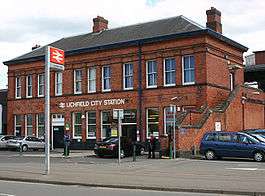Lichfield gun attack
The Lichfield gun attack was an ambush carried out by the Provisional IRA (IRA) on 1 June 1990 against three off-duty British soldiers who were waiting at Lichfield City railway station in Staffordshire. The attack resulted in one soldier being killed and two others badly wounded.[1] On the same day a British Army major was killed by the IRA in a gun attack outside his house in Dortmund, Germany.[2]
| Lichfield gun attack | |
|---|---|
| Part of the Troubles | |
 Front of Lichfield City Station where the attack took place | |
| Location | Lichfield, Staffordshire, UK |
| Date | 1 June 1990 14:49 (UTC) |
| Target | British military personnel |
Attack type | shooting |
| Weapon | hand guns |
| Deaths | 1 British soldier |
| Injured | 2 British soldiers |
| Perpetrator | Provisional IRA |
| Assailants | IRA Active Service Unit in Britain |
Background
The IRA had stepped up their campaign against British military targets outside Northern Ireland in the late 1980s. In May 1988 they killed members of the RAF in attacks in the Netherlands.[3] On 13 July 1988 nine British soldiers were injured when the IRA detonated two bombs at a British military barracks in Duisburg, Germany. On 1 August 1988 the first Provisional IRA bomb on the UK mainland in four years was set off by a timer device at the British Army base at the Inglis Barracks in Mill Hill, North London. The two storey building containing the single men's quarters was completely destroyed. One soldier, Lance Corporal Michael Robbins, was killed. Nine others were injured.[4] In September 1989 eleven Royal Marines were killed and 22 others injured when the IRA bombed their barracks in Deal, Kent, England.[5] On 18 November 1989 two British soldiers were wounded when an IRA car bomb exploded at a British Army barracks in Colchester, England. On 20 February 1990 the IRA bombed a British military recruitment office in Leicester, England. Two people were injured in this attack. Five days later on 25 February 1990, another recruitment office was bombed, this time in Halifax, West Yorkshire. Less than three weeks before the Lichfield attack 16 May 1990 the IRA detonated another bomb under a military minibus in London, killing Sergeant Charles Chapman, and injuring four other soldiers. After this attack the IRA released a statement which read "While the British government persists in its continued occupation of the north of Ireland the IRA will persist in attacking the British government and its forces in England".[6]
The shooting
On 1 June 1990 three off duty British soldiers were sitting on a bench on a platform at Lichfield City railway station. Suddenly two paramilitary volunteers from the Provisional IRA appeared on the platform, pulled out handguns and fired shots at the soldiers, then jumped onto the tracks, ran across the line and through a builder's yard opposite the station. The attack killed 18 year old private, William Robert Davies of Pontarddulais, south Wales and injured two other soldiers, Robert Parkin, 20, and Neil Evans, 19. A British Rail employee who witnessed the shooting said he jumped across the tracks to try to help the soldiers.
"I and a station employee tried to staunch the flow of blood from the chest of one of the soldiers", he said.
The three soldiers, who were in training at the Lichfield army base, were waiting for a train to nearby Birmingham for weekend leave, said Detective Chief Superintendent Malcolm Bevington.
A week before the attack two Australian tourists, Nick Spanos and Stephen Melrose were shot dead by the IRA mistaking the Australians for British off-duty soldiers.[7] These killings caused outrage across Australia, Britain and Ireland.[8]
Aftermath
The IRA released a statement after the attacks saying: "While British troops remain in Ireland such attacks will continue".[9]
The IRA continued their campaign in England and mainland Europe. On 9 June 1990 the IRA bombed the headquarters of the British Army's Honourable Artillery Company in central London, wounding 19 people. On 14 June 1990 a large IRA bomb badly damaged a building inside a British Army base at Hanover, West Germany. 25 June 1990 an IRA bomb exploded at the Carlton Club in London, injuring 20 people. One of the wounded, Conservative politician Lord Kaberry, died of his injuries on 13 March 1991.[10] As of 2019, no-one had been arrested for the murder.[11]
See also
- JHQ Rheindahlen bombing (Germany)
- 1988 Netherlands Attacks
- Deal barracks
- Osnabruck mortar attack
- 1990 Eltham bombing
References
- Malcolm Sutton. "CAIN: Sutton Index of Deaths". cain.ulst.ac.uk. Retrieved 27 November 2016.
- "British major shot by suspected IRA agents". UPI. Retrieved 28 August 2017.
- Sutton, Malcolm. "CAIN: Sutton Index of Deaths". cain.ulst.ac.uk. Retrieved 4 June 2018.
- Melaugh, Dr Martin. "CAIN: Chronology of the Conflict 1988". cain.ulst.ac.uk. Retrieved 4 June 2018.
- Sutton, Malcolm. "CAIN: Sutton Index of Deaths". cain.ulst.ac.uk. Retrieved 4 June 2018.
- "Minister Says London Being Subjected To IRA Terror Campaign". AP News. Retrieved 4 June 2018.
- Malcolm Sutton. "CAIN: Sutton Index of Deaths". cain.ulst.ac.uk. Retrieved 27 November 2016.
- "IRA Says It Mistakenly Killed Two Australian Tourists". apnewsarchive.com. Retrieved 27 November 2016.
- "IRA Kills British Soldier in West Germany, Another in England". apnewsarchive.com. Retrieved 27 November 2016.
- "CAIN: Chronology of the Conflict 1990". cain.ulst.ac.uk. Retrieved 27 November 2016.
- "Memory of our son's killing remains raw". Express & Star. 26 May 2013. Retrieved 14 February 2017.